Jennifer Hallock's Blog: Sugar Sun Series Extras, page 20
October 6, 2016
What’s So “New” about Imperialism?
In my last post for the Edwardian Promenade, I called the Edwardian Era an age of New Imperialism. What was so “new” about imperialism, you ask? Well, there were new players: Germany, Japan, and the United States, to name three. And there were new technologies: industrial transport and communication opened up the interiors of Africa and India, as well as tying together the disparate islands of the Pacific.

But one of the most puzzling aspects of New Imperialism was its doctrine: “Yes, we are here in your country, ruling your people, and pilfering your resources—but it is all meant to help you, not us.” Cue the world’s oppressed people saying: “Are you kidding me?”
 Cartoon from the April 1899 issue of Judge magazine.
Cartoon from the April 1899 issue of Judge magazine.Well, no, the imperialists were not kidding. In fact, they wrote poetry about how much they were not kidding. Here is Rudyard Kipling telling the Americans that it is their turn to play the game:
Take up the White Man’s burden–
Send forth the best ye breed–
Go bind your sons to exile
To serve your captives’ need;
To wait in heavy harness,
On fluttered folk and wild–
Your new-caught, sullen peoples,
Half-devil and half-child….
Take up the White Man’s burden–
The savage wars of peace–
Fill full the mouth of Famine
And bid the sickness cease;
And when your goal is nearest
The end for others sought,
Watch sloth and heathen Folly
Bring all your hopes to nought.
The people may hate you for it, Kipling was saying, but it is the Americans’ duty to colonize the Philippines and refashion the islands in the mold of Anglo-American civilization. You see, it was 1899. The previous year, as the opening salvo in the Spanish-American War, the United States had seized Manila. One small problem: they did not know what to do with it. Could this be the Americans’ own foothold in Asia, their economic entrepôt to compete with the Great Powers in China?
 December 1898 Puck cartoon shows Uncle Sam welcoming world trade in his off-shore entrepôt.
December 1898 Puck cartoon shows Uncle Sam welcoming world trade in his off-shore entrepôt.President William McKinley thought so. And, unlike those gauche Spaniards, the Americans would be enlightened rulers. He proclaimed:
…we come not as invaders or conquerors, but as friends, to protect the natives in their homes, in their employments, and in their personal and religious rights….[The American military must] win the confidence, respect and affection of the inhabitants of the Philippines…by proving to them that the mission of the United States is one of benevolent assimilation, substituting the mild sway of justice and right for arbitrary rule. [emphasis mine]
William Howard Taft, the first civil governor of the Philippines (and eventual President of the United States), was credited with saying that the Filipinos would be our “Little Brown Brothers,” which—get this—was too nice for the tastes of most Americans. U.S. soldiers on the march in the Philippines sang in response: “He may be a brother of Big Bill Taft, but he ain’t no brother of mine.” (The ditty was eventually prohibited by officers because it did not give a great impression, to say the least.)
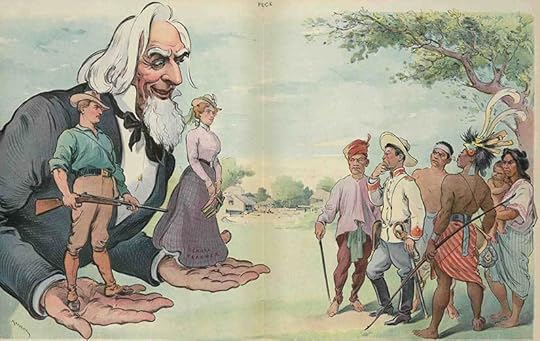 “It’s ‘up to’ them.” Uncle Sam gives the Filipinos the choice of either a soldier or a schoolteacher: the stick or the carrot. This Puck centerfold was published on 20 November 1901.
“It’s ‘up to’ them.” Uncle Sam gives the Filipinos the choice of either a soldier or a schoolteacher: the stick or the carrot. This Puck centerfold was published on 20 November 1901.To be fair, there were some attempts at benevolence by the Americans. To name a few: the establishment of the first secular, coeducational public school system in the islands; the creation of American university scholarships for the brightest Filipino youth; the building of ports, roads, telegraph lines, irrigation systems, hospitals, schools, and universities; the creation of a Filipino National Assembly; several Filipino Commissioners to advise the American governors; and a Supreme Court of the Philippines, led by a Filipino chief justice. This was not really democracy, but it was not the Belgian Congo, either.
 From left to right: The trench of dead Moros at Bud Dajo (1906), a demonstration of the “water cure” by the 35th Volunteer Infantry, and the news headlines about General Smith’s orders to kill all Filipinos capable of bearing arms, which he defined as over the age of ten.
From left to right: The trench of dead Moros at Bud Dajo (1906), a demonstration of the “water cure” by the 35th Volunteer Infantry, and the news headlines about General Smith’s orders to kill all Filipinos capable of bearing arms, which he defined as over the age of ten.Still, there were plenty of ugly aspects to American rule in the Philippines, as you can see above. Occupation is always dirty. There was the Moro War, the water cure, and the Howling Wilderness of Samar. And, of course, there were the double-standard economic policies of the insular regime. The Americans set up a system by which American goods were sold in the Philippines tariff-free, but Filipino goods were taxed twice, both when they were exported from the Philippines and when they arrived in the United States. Where did that tariff revenue go? To pay the tab of the American administration, of course.
The hypocrisy of New Imperialism prompted English writer and politician Henry Labouchère to write the “Brown Man’s Burden”:
Pile on the brown man’s burden
To gratify your greed;
Go, clear away the “n—”
Who progress would impede;
Be very stern, for truly
’Tis useless to be mild
With new-caught, sullen peoples,
Half devil and half child…
Pile on the brown man’s burden,
compel him to be free;
Let all your manifestoes
Reek with philanthropy.
And if with heathen folly
He dares your will dispute,
Then, in the name of freedom,
Don’t hesitate to shoot.
Before you pat Labouchère on the back for his progressive skewering of Kipling’s motives, do know that he was an homophobic campaigner whose most lasting legacy was the Labouchère Amendment that made all sexual activity between men a crime. (This is the law that Oscar Wilde and Alan Turing were prosecuted under.) And Labouchère was not the only anti-imperialist who might disappoint our modern sensibilities. Both Andrew Carnegie and William Jennings Bryan were anti-imperialists, but their opposition was actually based on racism of all things. Carnegie wanted us to only take land that would “produce Americans, and not foreign races,” and Bryan worried about Chinese and Filipino immigration “exciting a friction and a race prejudice” that would damage America’s homogeneity.
 Images of Carnegie, Bryan, and Twain from the public domain.
Images of Carnegie, Bryan, and Twain from the public domain.Before you despair, though, let’s move onto Mark Twain, whose essay “To the Person Sitting in Darkness” is one of the best pieces of political satire ever published, in my opinion:
Shall we? That is, shall we go on conferring our Civilization upon the peoples that sit in darkness, or shall we give those poor things a rest? Shall we bang right ahead in our old-time, loud, pious way, and commit the new century to the game; or shall we sober up and sit down and think it over first? Would it not be prudent to get our Civilization-tools together, and see how much stock is left on hand in the way of Glass Beads and Theology, and Maxim Guns and Hymn Books, and Trade-Gin and Torches of Progress and Enlightenment (patent adjustable ones, good to fire villages with, upon occasion), and balance the books, and arrive at the profit and loss, so that we may intelligently decide whether to continue the business or sell out the property and start a new Civilization Scheme on the proceeds?
In a similar vein, Twain also “updated” the lyrics of the Battle Hymn of the Republic, Julia Howe’s abolitionist hymn, to more properly reflect what he felt Americans had been doing in the Philippines:
Mine eyes have seen the orgy of the launching of the Sword;
He is searching out the hoardings where the stranger’s wealth is stored;
He hath loosed his fateful lightnings, and with woe and death has scored;
His lust is marching on.
And, if that was not enough, Twain redesigned the American flag to include skulls and crossbones instead of stars. Twain gives us some faith that not every American bought into the plunder-but-call-it-progress ideology of New Imperialism.
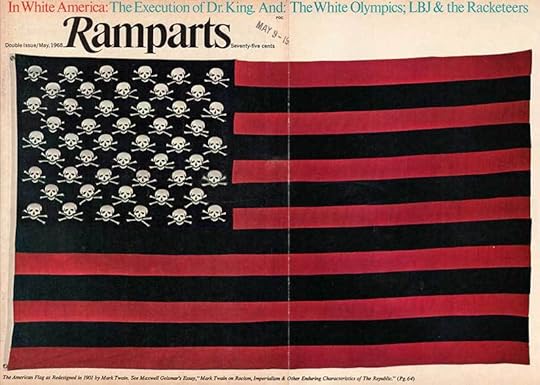 The American Flag as redesigned in 1901 by Mark Twain. Image found here.
The American Flag as redesigned in 1901 by Mark Twain. Image found here.Featured image at the top of the page is the 20 March 1901 cover of Puck.
September 29, 2016
Sugar Sun series glossary term #26: aswang
Sugar was such a greedy crop, drinking the lifeblood of the soil like the aswang demons that peasants feared.
With the popularity of the Twilight series—or, let’s get old school with Anne Rice’s Vampire Chronicles—I am surprised that more writers have not widened their paranormal worlds to include the macabre supernatural folk traditions of the Philippines.
Aswangs are lady vampires…on steroids. Though legends vary, the Aswang Project website has come up with three common characteristics in them all:
The aswang’s diet consists mainly of human liver and blood;
It has an unholy preference for unborn children; and
It is also known to prey upon children and sick people.
Um, did you notice number two? Aswangs have been blamed for miscarriages and stillborn babies all over the islands. As this website describes:
When they know of a pregnancy…they would land on the roof of the pregnant woman’s home, and, trying to remain undiscovered, dig a hole to get inside. Once close, they use their razor-sharp teeth and their tongue that can stretch out as a thin wire to drink the blood and eat the fetus through the mother’s belly button…
Even worse, there is a related creature called a manananggal, who is a beautiful woman by day, but at night she detaches the upper half of her torso, sprouts bat-like wings, and flies around with her guts hanging out, looking for victims. This is serious stuff.
 A manananggal as pictured at Florente Aguilar’s guitar project site, Aswang: Tagalog Song Cycle.
A manananggal as pictured at Florente Aguilar’s guitar project site, Aswang: Tagalog Song Cycle.The aswang legends are particularly popular in the Western Visayas region, near where the Sugar Sun series is set. In fact, when Silliman University in Dumaguete opened their first dormitory in 1903, people thought it was haunted with these very creatures. That would be enough to keep me home, thank you very much.
Why the Visayas? I do not think that it has anything to do with infant mortality rates, which historically were high everywhere. One theory is that Spanish Catholics spread the legends to vilify female folk healers, especially those in the interior of the southern islands. These pagan women were far away from the friars on the coasts and the Crown in Manila—and, therefore, they were not to be trusted.
You may be wondering, how are aswangs created in the first place? Getting bitten, like by a European-style vampire, is not going to do it. (You would just be dead, I think.) In the Filipino version, the dying aswang vomits up a small black chick—as illustrated below—which the aswang-to-be must swallow. Waiter, check please.
 Image from Erik Matti’s “Tiktik: The Aswang Chronicles,” found at the AswangProject.
Image from Erik Matti’s “Tiktik: The Aswang Chronicles,” found at the AswangProject.In European folktales, like those of the Brothers Grimm, the big bad wolf is eventually punished for eating children. But the victims of aswangs get no such justice. (Maybe because carrying a child to term and then actually delivering it has been the most dangerous thing a woman could do for most of history.)
This is very dark stuff. I don’t write novels this dark, but someone should. Maybe a new paranormal venture from #romanceclass? I cannot imagine an aswang hero, but maybe you can convince me. Or maybe not.
Featured image from Season 3 of Grimm.
September 23, 2016
Find Jen at the Edwardian Promenade
I am thrilled to announce that I will be posting biweekly on Evangeline Holland’s magnificent website, the Edwardian Promenade. Established in 2007, this site is the #1 resource for readers, writers, and students alike for everything Edwardian. As years have passed, the site’s focus has widened beyond 1900-1914 Britain to include global society between 1880-1930. While you are there, take a look through this fantastic, rich site, and check out what Evangeline has been up to, both scholastically and artistically (including her own novels).
I will be cross-posting here, too, so you will not lose any content from this site. To see my introductory post, click here. Since I cut my hand unloading the dishwasher last night, now have eight stitches in my left hand, and am typing this post one-handed—only me!—I will keep it short. Happy reading, everybody!
September 15, 2016
Hingham Public Library this Monday!
Hotly contested stump speeches on transpacific trade, immigration, and Muslim separatists aren’t new to American political discourse. Join historian, teacher, and author Jennifer Hallock to learn how our first experiment in overseas empire in the Philippines (1898-1946) still shapes our country now.
 Clockwise from top: Ospreys at Clark Air Force Base (Philippines); The Spratly Islands; and the USS Topeka at Subic Freeport (formerly Subic Naval Base).
Clockwise from top: Ospreys at Clark Air Force Base (Philippines); The Spratly Islands; and the USS Topeka at Subic Freeport (formerly Subic Naval Base).What has brought the Americans full circle back to the Philippines, and why do some Filipinos want them to turn right around again? If you are in the Boston area, please come to the Hingham Public Library this coming Monday, September 19th, at 7pm.
Apparently, there will be community cable television there, so I need all the friendly faces I can get!
September 8, 2016
Researching Micro-History Workshop at Fiction Fest 2016
Tomorrow I will be leaving for CTRWA’s Fiction Fest 2016 at the Norwalk Inn in Norwalk, Connecticut. While I am there, I will be presenting a little bit of insight on how I research and write. I’ve posted on this before, but this time I’ve put togehter a bit more detail on my methodology.
True micro-history writes the best fiction.
What is micro-history, you ask? It is the investigation of small units in history—an individual, a small village, a family, or a school, for example. Why is this important? Because large trends, the kind of history you get in encyclopedias, smooth out history to give you only the most average experience. And who likes to read about average? No one!
You want to know about the heroes and heroines—by definition, the outliers, the dangerous, the obscure, the interesting! Part of what authors are selling is the chance to live someone else’s life for a little while. Maybe your character is Marianne, a half-Jamaican hotelier seduced by a spy during the Crimean War; or Lily, a diplomat’s daughter who rescues a wounded American Marine in the Boxer Rebellion in China.
Marianne and Lily are not typical, but they are believable because they are based upon real people—real outliers. My inspiration for Marianne came from The Wonderful Adventures of Mary Seacole, while Lily is based on Laura Conger in Sarah Pike Conger’s Letters from China. Cool books! Where did I find them, you ask? The second half of my workshop will explain how to find primary sources for free on the internet: books, articles, artifacts, photographs and videos (if available), illustrations, newspapers, and more, all from the time period itself.
Before that, though, I will talk about how you can use the sources you find. You are not writing a biography, after all. How do you know what facts to use and what to make up? I came up with five models to help you figure it out:
The Ice Cube Tray Model
My fake characters Marianne and Lily are based upon the broad outlines of real people, but if I actually wrote books for them I would make up individual personalities, hopes, dreams, senses of humor, and more. For another example, let’s use a book I did write: Della Berget, heroine of Hotel Oriente, was inspired by a real-life outlier, Annabelle Kent, author of the memoir, Round the World in Silence. This middle-aged, deaf world traveler gave me the raw material to write a young, deaf aspiring journalist. To suit my own purposes, I gave Della a US congressman for a grandfather—loosely based on a real one, Senator Albert Beveridge—and plopped her in the middle of 1901 Manila, where carpetbaggers like her could make a name for themselves. Elements of Della come from Annabelle’s story, but the real person is an incomplete mold, like an ice cube tray. I filled in the rest.
The Straitjacket Model
What if you don’t focus on a specific person? In fact, quite the opposite. What if you highlight the social constraints of a chosen era—the rules that pen in the people? Guess what? You have the formula for a clever foil, or even villain, to represent “society” as a whole—without being average. I did this for Archie Blaxton, the man you loved to hate from Under the Sugar Sun. I took every horrible thing that came out of an American’s mouth (or memoir) about the Philippines, and I gave it to Archie. He became an amalgam of all the worst Americans I could find. (People suck, by the way.) I call this model the straitjacket.
The Open Flame Model
Real history can also provide conflict, too. I needed a scandal for Hotel Oriente, something to put a little pressure on my hero, Moss North. (Moss, by the way, was based on the real manager of the real Hotel Oriente, West Smith. Get it? West Smith became Moss North?) By searching some American newspapers, I found a real scandal that almost brought down the Oriente, gutted the Manila quartermaster’s office, and sent a handful of men to prison. Good conflict adds heat underneath your character’s feet, prompting them to make pivotal decisions—and declarations of love! I call this the open flame.
The Millstone Model
For my upcoming book, Sugar Moon, I gave my hero, Ben Potter, a troubled past. He was traumatized caused by a real event: the 1901 attack at Balangiga in which 48 American soldiers were killed by angry villagers. Ben’s memories will be shared in flashback form because they shaped Ben into the man he is, for better or worse. (Most of you would say worse, but give him a chance. Or second chance. Well, okay, third.) Ground down by the millstone of war, he is someone new because of this real event. It is a big part of his internal conflict.
The Fridge Magnet Model
Finally, I use real vignettes and anecdotes throughout my books. A lot of people remember the snake scene in Under the Sugar Sun, and I wish I could take full credit for it. But that really happened to a real American on one of his first nights in the Philippines in the early 1900s. He even had to buy a replacement snake, too! There’s some stuff you cannot make up, and you shouldn’t have to. But you do need those little details that make your book convincing.
Consider this: when you walk into a house, where do you find the small details important to that family’s daily life? On their fridge. (Or their medicine cabinet, but that’s an invasion of privacy. Shame on you.) Therefore, I call this the fridge magnet model. These little snippets tell your reader more about a character or setting than Mr. Exposition ever could. For example, the snake story told me how clever rural Filipinos were to use one pest to control another; and it told me that Georgie, for all her pluck, wasn’t going to get anything right her night in Bais. Her “fish out of water” anxieties will be essential to her later conflict with Javier.
Conclusion
Whenever I approach a primary source, I think: how can this event advance my story or my character development? And you need to be thinking this, too. No matter how much fun it is to research—no matter how many rabbit holes you want to fall down—everything should move your book forward. Stay focused on these five models. I hope they help!
By the way, here is the handout of websites that I cover in the workshop’s “how to” portion, along with some Google shortcut tips: Hallock Micro-History Researching Tips. Happy researching!
September 1, 2016
The Year of Living Writer-ly
Today was the first day of the rest of my year.
Sure, I’ve been on summer break already, and it’s been excellent. It’s always excellent. Speaking of which, have you heard this one?
Question: Name three reasons to become a teacher.
Answer: June, July, and August.
Funny, right? But today, September 1st, I would have normally returned to school for professional development meetings. And guess what? I didn’t go.
Instead, I have the next twelve months to live the dream as a full-time writer. It’s called sabbatical. Awesome, I know. But before you imagine me lying around the house in my pajamas—though odds are good on that—I should mention that I have plans. Big plans. Big.
First, I will be continuing to write, edit, and publish the Sugar Sun series, and you can’t stop me. Rosa’s novella, Tempting Hymn, will be out this fall. The two other main books in the series, Sugar Moon and Sugar Communion, will follow. I may not be fast, but I want to get the books right, which means a lot of rewrites and even more editing. If you would like to find out when I actually publish them, please sign up for my Sugar Sun newsletter. Thank you!

Second, I will be giving my Researching Micro-History workshop this fall at Fiction Fest 2016 (September 9-11) and at the Rhode Island Romance Writers’ meeting on October 1st. The workshop is one third Ted-Talk-ish explanation about making true history write the best fiction, and two-thirds research tips, sites, and how-tos. It’s not just for historical writers, either.
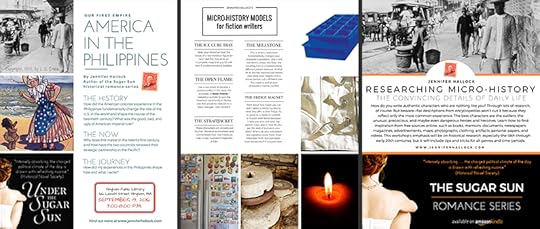
Third, I will be giving my “America in the Philippines: Our First Empire” talk at local libraries—and anywhere that anyone with a projector wants to hear it. Here’s the pitch: “Hotly contested stump speeches on transpacific trade, immigration, and Muslim separatists aren’t new to American political discourse. Join historian, teacher, and author Jennifer Hallock to learn how our first experiment in overseas empire in the Philippines (1898-1946) still shapes our country now.” You want to hear more? I will be at Hingham Public Library on September 19th, so come check it out.

Fourth, I’m on the planning committee for the 2017 NECRWA Let Your Imagination Take Flight conference (check out our Facebook page!). It’s already been fun to plan, and I hope to see everyone there. Look at those featured authors! And that’s just the beginning, trust me. There will be a book signing on Friday, April 7th—so readers, put that on your calendar.

For the other conferences I’ll be attending, see the updated schedule below:

Finally, Mr. H and I are going to travel. I especially look forward to the Philippines in February—because February in Manila is soooo much better than February in New Hampshire. And it’s going to be awesome to finally meet everyone I talk to daily on the interwebs. Also on the docket is a trip to Scotland, maybe returning on a trans-Atlantic cruise—very old school. Until then, I will be here on the farm, playing Pied Piper to a flock of chickens. Seriously, they follow me around. And I have three baby chicks right now, too. Adorable.

Here’s to a great year! Let’s get writing…
August 26, 2016
Save the Date: New England Chapter RWA Conference April 7-8, 2017
I’m a planner of novels but not an event planner. The whole idea frightens me, in a flying-through-a-narrow-trench-on-the-Death-Star-to-find-its-only-vulnerable-point-while-there-are-TIE-fighters-everywhere kind of way.
But when friends in NECRWA, the New England Chapter of Romance Writers of America, came forward with great ideas for next year’s Let Your Imagination Take Flight Conference, I wanted to be a part of their success. With a group like this, how can you go wrong?
An Inside Look at the Committee
 These are only a few of the full-length novels produced by this talented group. Follow author links below to buy books. I recommend them all!
These are only a few of the full-length novels produced by this talented group. Follow author links below to buy books. I recommend them all!The real leader of our charge is Kristen Strassel, one of the most innovative and prolific independent authors I know. We joined NECRWA the exact same month: January 2013. Since this time, she’s published at least 26 books by my last count, in both the paranormal and contemporary subgenres. (In contrast, I’ve published two books in one subgenre.) The woman gets shit done, so it is not surprise we asked her to take the reins. She’s also a talented makeup artist by day (and sometimes by night, too).
I’m the vice chair, which means I give encouragement on vice to the chair. Okay, I can do that.
Jen Doyle is the registration chair. Before you say, “I’ve read Calling It, and this is one funny woman. Why did you give her such a boring job?” please do know that she wanted it. She’s got day job skills, you see. And she’s organized. I mean, have you seen her Facebook parties? If not, join her and two other great authors this Monday, August 29th, here, for the release of her second novel by Carina Press. Jen writes sexy and clever sports romance with small-town feels.
Our workshop chair is Stephanie Kay, who just released her debut novel, Unmatched, to great acclaim: 4.9 out of 5.0 stars on Amazon! Holy reviews, Batman! Steph’s biting sense of humor comes through in her writing, but it also makes her a lot of fun to work with. She’s passionate about bringing together the most innovative and helpful workshops possible. If you’re interested in presenting at our great conference, email her at conference_workshops@necrwa.org or submit an online form here.

Our agent and editor chair is Tamsen Parker, who writes emotionally intense BDSM erotic romance, or “elegant superfilth.” Believe me, it delivers on all those promises. Her experience as an agented hybrid author gives her great insight into all facets of our industry, which is why she was the natural choice for A&E. And if you could just see her desk calendar and washi tape, you would know that she has her act together. She puts the elegant in superfilth.
Kari Lemor is our book fair chair, when she’s not working as secretary of our chapter! She had her first novella published as a part of the Beautiful Disaster Anthology, and she has three novels coming out soon from Kensington. She’s one to watch, and she’s a super sweet person, too!
Finally, you’re not going to find this on our conference webpage, but here’s a scoop for you. We have two more committee members-at-large: Teresa Noelle Roberts and Alexa Rowan. Both have been incredible supportive to me over the last few years. Teresa is a veteran author of fantastic paranormal, science fiction, and erotic romance, yet she was kind enough to take newbies like me under her wing. I’ve beta-read her latest release, Buck, Naked, and it is a cheeky, suspenseful sci fi interracial romance with loads of sexy. Just dreamy.
Some newbies make a splash: Alexa won the 2015 RWA Golden Heart award (a big effin’ deal for unpublished romance writers) for Best Short Contemporary Romance. Check out the winning book, Winning Her Over, for yourself. She writes swoony romance for the professional woman featuring hot lawyers, sexy massages, and smart plots. She’s our resident perfectionist, too, so any typos in this post are mine and mine alone.

That’s the gang. We write different stuff. Some of us are cat people. Some are dog people. At least a few of us are bird people (including chickens). But you’ll have to trust me on this: we get on really well. It’s awesome how much we like each other, and this chemistry will infect every minute of the conference. You gotta come.
The Speaker Teaser
Did I mention that we have an amazing line up? First, there’s Joanna Bourne, our keynote speaker, who has no idea that she was a key influence in my own writer-origin story. Her Spymaster Series takes place in the French Revolution and Napoleonic Wars—and, as a professional historian, I have to tell you, these books are amazing. I have one name for you: Hawker. You’ll find out.

Joanna’s latest novella is in a delightful anthology called Gambled Away, and guess what? Our Master Class teacher, Molly O’Keefe, is in it with her! (And check out that cover below. It’s one of my favorites of all time. I wish it was mine.) Molly writes historical, erotic, contemporary, and category romance—all sizzling. She’s won two RITA awards (a big effin’ deal for published authors) and some Romantic Times kudos, too. You don’t want to miss this chance to pick her brain.
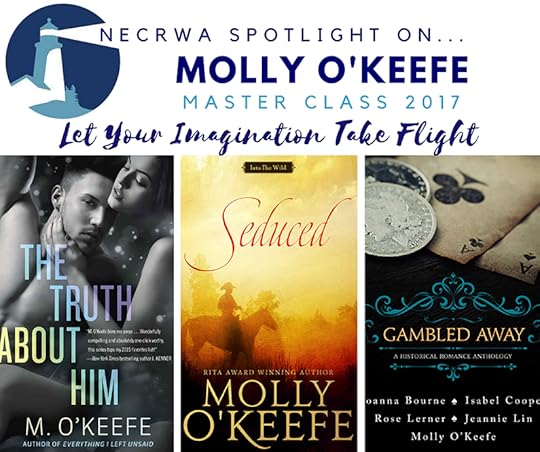
Last but not least, we will be wowing you at lunch with Zoe York. What a repertoire this woman has. Small town romance? SEALs? Vikings in Space? Yes, please. And, if you want something a little more naughty, check out her alter ego, Ainsley Booth. This woman has got you covered…um, literally. I mean, check out those covers!

Sign me up, you say? Stay tuned at our Facebook page for all the latest information on registration and the workshop program. See this and more links below. We look forward to seeing you in April.
It may be premature for thanks, but who cares? Thank you to all the great NECRWA committees that paved the way, and a special shout out to the Board of Directors for their guidance, support, and enthusiasm. The current board includes Myretta Robens (president), Patricia Grasso (vice president), Jackie Horne aka Bliss Bennet (treasurer), and Kari Lemor (secretary, as linked above).

I could go on and on, but those books in your pile are not going to read themselves. Or maybe you’ve got audio editions and they will. Just go do it!
Conference & Chapter Links
New England Chapter of RWA Conference Page
Conference Twitter: @NECRWA
Conference Instagram: necrwa
August 19, 2016
Sugar Sun series glossary term #25: boondocks
No, not these boondocks:

They are probably fine entertainment, though I haven’t seen either. And not this Boondocks, either:

(Coincidentally, this tavern used to be in my hometown in New Hampshire of all places. It has changed name and ownership since, but what are the odds?)
But, no, I mean none of the above. I mean the boondocks behind me in this photo:

Bundok is the Tagalog word for mountain. When American soldiers arrived in the Philippines in 1898, they adopted the word and, of course, changed its meaning. Because ‘Merica. U.S. Marines, in particular, made “boondocks” a buzzword for everything from jungle to backwoods to, in fact, mountains. In their minds, whatever looked “wild.”
For the first half of the century, it remained specialized military slang. One source claims that boondocks appeared in the 1909 Webster’s New International Dictionary, but if so this was the first print usage by at least 30 years. The Online Etymology Dictionary also recognizes the word’s vernacular use as early as the 1910s, but it was otherwise not published until 1944 in the Marine Corps Reader—interestingly, describing Parris Island, South Carolina, a Marine Corps training station that looks pretty flat to me.
In World War II, the word was revived, not only among American fighting forces in the Pacific, but also among those soldiers’ and sailors’ families Stateside, too. The Vietnam War reinforced this usage, and now the word is ubiquitous: being out in the boondocks means being in an isolated or wild region. And, yes, my town in New Hampshire probably counts. I’m proud to live in the boondocks—but I just wish it were closer to the real mga bundok (Philippine mountains).
 A selfie before smart phones—and selfie sticks.
A selfie before smart phones—and selfie sticks.Featured photo by Jojo Nicdao in the Creative Commons, found here.
August 12, 2016
Sugar Sun series glossary term #24: quartermaster
Quartermaster is a military word, and therefore it may be as unfamiliar to you (or more so) than the other phrases in this glossary. According to the Oxford English Dictionary, the term comes from the Middle Dutch word quartiermeester, the naval officer responsible for organizing the watches. This duty was expanded to include all provisioning—from rations to ammunition, from rifles to haversacks, and from ships to horses.
 Two views of the Quartermaster Depot of Southern Luzon in Binondo, Manila, c. 1900.
Two views of the Quartermaster Depot of Southern Luzon in Binondo, Manila, c. 1900.Today, military logistics is more important than ever. The US Armed Forces recruits men and women with engineering and business degrees to keep the soldiers, sailors, aviators, and marines “marching on their stomachs.” But during the Philippine-American War, it seems that anybody could get a job in the quartermaster depot. Why were they so desperate?
After the Civil War, the United States Army had shrunk to a size smaller than today’s New York City Police Department. Think about that for a minute. Yes, there were small military interventions in Mexico, Korea, and Samoa, in addition to a series of conflicts known as the Indian Wars, designed to consolidate Federal control over the rest of North America. But at the time Americans feared they would lose their liberty to a large standing army, so the military remained small despite it all.
When the Spanish-American War began, Congress found itself in a bind. At first they relied upon volunteer units from each of the states, but those enlistments were only a year long. When the Cuban conflict turned into a protracted war in the Philippines, Congress doubled the size of the regular Army once, then twice. For the first time, the US sent a large force to Asia—up to 69,000 at a time—to fight its first overseas war of occupation.
This huge force needed to be fed and armed. If you could read and write, you might be able to swing a job “in the rear with the gear,” rather than wading through rivers and rice paddies under fire. And, if you had an entrepreneurial spirit, a golden opportunity beckoned: crates and crates of goods came in, and who was to say if a few hundred pounds here or there was “lost”?*
One of these “entrepreneurs” was Captain Frederick J. Barrows, who was found to have been embezzling $100,000 a month—the equivalent of $2.9 million in today’s terms—in flour, bacon, and other staples. He then sold the goods to local hotels, bakeries, and restaurants.
 The Los Angeles Herald tells of the Manila quartermaster fraud in 1901.
The Los Angeles Herald tells of the Manila quartermaster fraud in 1901.Barrows got away with this scheme for almost a year. In sum, he and his accomplices probably made (and spent) about $24 million in 2015 dollars. Even now, that goes a looooong way. As the article says, Barrows used his ill-gotten gains to lead “a scandalously immoral life…entertaining officers,” which means he was throwing big parties with lots of prostitutes. It’s good to be the quartermaster.
But, be careful: if you steal while you’re in the Army, and steal from the Army, you get punished according to Army regulations—in this case, five years imprisonment in Bilibid Prison in Manila, which might have been worse than Leavenworth. The Spanish built Bilibid but never imprisoned their own citizens inside, which is never a good combination. Don’t let the quaint postcard below fool you.

So you see, the scandal I used in Hotel Oriente was a real one. But my hero, Moss North, managed to avoid the dragnet. How? Read the book and find out. It’s available free on Kindle Unlimited or for purchase at only $0.99.
* In the “history repeats itself” column, the US sent plastic-wrapped crates of cash—$12 billion dollars worth—to Baghdad in 2004, and about half of that seemed to disappear. It was called “the largest theft of funds in national history.” But don’t worry—the Department of Defense finally accounted for the funds in 2011, which to some was 7 years too late.
August 4, 2016
Sugar Sun series glossary term #23: barong tagalog
Pressed against Javier’s arm as they waited for the band to begin, Georgie studied his barong tagalog. It was simple ivory with a plain collar—elegant and traditional—not dyed or striped or ruffled. He had also chosen geometric embroidery over floral. Still, it was not exactly a modest garment. Though the piña felt sturdy and substantial where it brushed her skin, it was so sheer it displayed his snug undershirt with remarkable definition.
“Why wear a shirt so thin that you need a second layer?” she asked, eyes fixed where his short sleeve revealed some bicep. “Isn’t that hot?”
One eyebrow shot up. “It depends with whom I’m dancing.”
—Under the Sugar Sun
Oh, Javier.
But he’s not entirely wrong. There is a rare intersection of sexy and convenient going on here. The barong tagalog (the “Tagalog shirt”), or just barong, is the formal garment for men in the Philippines. No tie. No tucking the darn thing in. What’s not to like? At least, that’s my husband’s attitude. He actually went to fancy dress parties and weddings in Manila, as a result. He’s even worn his here in the States.
He doesn’t look this good in his—shhh, don’t tell him—but he looks pretty good:
 Three handsome men in barongs, including Prime Minister Justin Trudeau of Canada (far left). Find photos here, here, and here.
Three handsome men in barongs, including Prime Minister Justin Trudeau of Canada (far left). Find photos here, here, and here.If you do a little research on the barong, you’ll run into an urban myth—at least, from what I could find, it is an urban myth. I’ll let Javier tell it:
He flicked the loose tail of his shirt. “I’ve always been told that the Spanish required the indios to wear these so we couldn’t hide our daggers underneath.”
Georgie wondered if these islands had ever known peace. “Is that true?”
“It’s certainly the kind of thing the Crown would have done, but there’s no specific law anyone can point to.” Javier paused, his brown eyes studying her. “It makes a good story—and at Spanish expense, too, which makes it even better—but in truth the barong is probably all Filipino. Do you like it?”
Georgie looked up the shirt line and across his chest. “I do.”
He leaned down and whispered in her ear. “I would wear anything to catch your attention, Ina. Or nothing.”
You can find some historic examples of barongs at my Pinterest site on traditional Philippine dress. And if you keep digging, you’ll find there’s lots of variety: ruffles, fabrics, cuffs, length, and more. Some have floral designs, and others geometric. Some are dyed, others are natural piña. All look pretty terrific on a handsome man, though, and isn’t that all we want in the end?
Featured image by Angel N at Flickr.
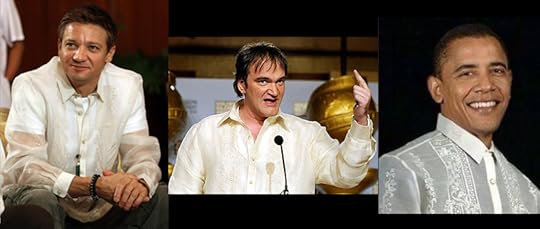 Three more non-Filipino barong wearers. Who wrote it best? Far left is actor Jeremy Remmer, pictured in Manila to shoot Bourne Legacy. The middle is filmmaker Quentin Tarantino at the 2007 Golden Globe nominations. Far right is President Barack Obama at the 2015 APAC Summit. Most experts agree on Obama with the win, and Remmer second. It’s all about the undershirt. Read on.
Three more non-Filipino barong wearers. Who wrote it best? Far left is actor Jeremy Remmer, pictured in Manila to shoot Bourne Legacy. The middle is filmmaker Quentin Tarantino at the 2007 Golden Globe nominations. Far right is President Barack Obama at the 2015 APAC Summit. Most experts agree on Obama with the win, and Remmer second. It’s all about the undershirt. Read on.EPILOGUE: My husband thought that I left out the most famous non-Filipino to wear a barong, Quentin Tarantino. But there is a problem with Tarantino’s high-profile debut of the garment at the 65th Annual Golden Globes Nomination ceremony in December 2007: he forgot the undershirt. And he left it unbuttoned at the collar, which made the lack of undershirt even worse. His general look of dishevelment did not help matters. As a result, many Filipinos felt he did not present the Tesoro barong at its best. (It was a gift by the Film Development Council of the Philippines, by the way, and Tesoro’s made it in a day. The source is quick to add that Tarantino was, in fact, given an XXL undershirt.) At least the filmmaker wore it with genuine affection, and isn’t that the most important thing?
Sugar Sun Series Extras
- Jennifer Hallock's profile
- 38 followers











